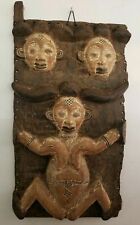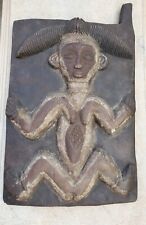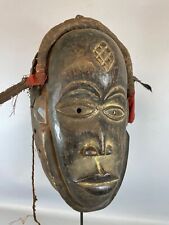Rare Punu Mukudji African Wood Granary Door Panel Mask Okuyi Figures - Gabon

When you click on links to various merchants on this site and make a purchase, this can result in this site earning a commission. Affiliate programs and affiliations include, but are not limited to, the eBay Partner Network.
Rare Punu Mukudji African Wood Granary Door Panel Mask Okuyi Figures - Gabon:
$3584.99
In traditional African art, creating exact likenesses is not seen as a complete representation of ‘beauty.’ There is no such thing as lifelike art with striking realism. In short, in traditional African art there is no Mona Lisa. Instead, emphasis is placed on theunseenaspects present in true female beauty. While this may release a figure from having perfect physical proportions, it elevates spiritual relevance to a point far beyond most western works. In the eyes of the Punu people, beauty is more than just curvy hips or athletic bodies. Beauty is represented by inner qualities that we cannot always see. ~Misaki Imagawa
ANTIQUE HAND CARVED ART OF THE PUNU TRIBE OF GABON, AFRICAWOOD MUKUDJI PANEL SCULPTUREDDOOR GRANARY
A rare vintage work of Mid 20th century African art - Item is pictured in good conditionA Punu wood door has been carved in relief form representing the delivery after pregnancy with splayed arms and legs carved in relief below two masked figured heads carved in relief form as well. The figures all are colored with with Kaolin. The detail is impeccable.
Dimensions : 47 1/4 inches in Height 25 1/2 inches in Width and 3\" inches in Depth from front to backMaterial: Figure and two maskedOkuyifigures are carved colored with white kaolin patinaCondition: Fine aged condition, signs of age and use, in situ restoration. Please review images in the photo gallery. Item is as described.
Punu doors from Gabon are used as a protection for granaries against wild animals and thieves. The female figure (representing fertility) is colored with oxydised white kaolin and shows an intricate detailing; in fact, you can admire an elaborate two-part coiffure, as well as body scarification.In many cases, doors like this were also used to protect ritual houses or other buildings keeping personal objects, like family shrines, or to decorate your home today.
Okuyimasks appeared during community rituals linked to important events of village life (funerals, end of mourning, youth initiation, transgressions of clan orders, birth, epidemics, etc). Representing female entities from the world of spirits or the dead, the masks capture an ideal of beauty. They are characterized by a face with youthful features, half-closed eyelids under slightly raised arching eyebrows, a fine realistically-rendered nose, a mouth pursed forward with full red-painted lips, painted red, and an elaborate crested coiffure.The two-crested hairstyle of the Kunin mask is particularly prestigious - and rare. Varying by region, some masks have lozenge-shaped scars on the front and quadrangular patterns on the sides, punctuated by thick \"scales\" painted in bright red. These nine scales in relief evoke not only the nine mythical primordial clans from which all Punu-Lumbo groups derive, known in oral traditions by the namaka, but also the crocodile as a totemic animal.
Door.The 40,000 Punu reside on the left bank of the Upper Ngoume River (Gabon) and belong to the group of tribes known as Shira. They live in independent villages divided into clans and families, and social cohesion is ensured by a society known asmoukouji. Its primary role is to regulate community life with regards to social and judicial matters, and mainly it applies itself to the neutralization of evil forces.This example of the ‘displayed female motif’ is decorated with an elaborate coiffure and body scarification. Costumed stilt dancers wore Punu masks with a similar face. This image represents the spirit of beautiful young woman who returned from dead to participate in village life. The whitened figure makes reference not only to the dead, but also to anti-witchcraft techniques. Witches were believed to be most active and powerful at night, and whiteness refers to light and clarity, which stand in opposition to night and mystery. In Gabon and much of central Africa clairvoyants ring their eyes with white clay (kaolin) as a strategy for detecting witchcraft.
PUNU (APONO, BAPUNU, MPONGWE, PUONOU, PUNO)Gabon
The Punu reside on the left bank of the Upper Ngoume River (Gabon) and belong to the group of tribes known as Shira which were originally part of the Luango kingdom of Angola. With the Eshira, the Lumbo, the Vili, the Galoa, and the Vungu people, the Punu migrated northwards during the 18th century and settled in the area where they continue to inhabit to this day. They live in independent villages divided into clans and families, and social cohesion is ensured by a society known as moukouji. Its primary role is to regulate community life with regards to social and judicial matters, and mainly it applies itself to the neutralization of evil forces. To this end, officiates of moukoudji utilize a cult kit that includes statuettes, human relics and masks.
Punu masks represent idealized female ancestors\' faces. The white color of the mask is genderless; white is a symbol for peace, deities, spirits of the dead, and the afterlife. It is thus the predominating color in funeral celebrations and memorials. Therefore the masks were worn during funerals. They appeared also in the magical rites whose function was to unmask sorcerers. The masks have realistic, mostly white but sometimes black faces with protruding pursed lips, globular protruding eyes incised with a curve, high-domed foreheads, and characteristic rigid high coiffures reflecting the Punu women\'s hair styles. The masks often have an Oriental expression, but no such influence has been established. Many Punu masks can be recognized by raised diamond-shape scarification marks on the foreheads and temples. The scarification marks on the temples are thought to be associated either with a female ancestor, or with a southern sub-group of the Punu tribe. Black face-masks have exactly the same stylistic characteristics as the white masks, but they are believed to have a judiciary function and help identify sorcerers. The performances of the masks are nowadays intended primarily to entertain audiences on festive occasions. Only rarely do the masqueraders fulfill a ritual function of officiating at funerals, when they dance as embodimentof the ancestor spirits. In performances the dancers, wearing costumes of raffia or cotton fabric and animal pelts, move with amazing acrobatic agility on stilts up to six and a half feet in height.
The Punu also carve standing reliquary figures, which watch over the bones of the deceased. Punu artists carved also amulets and everyday objects showing faces similar to those found on masks. It is thought they were used as prestige objects, during magical ceremonies, or were kept alongside the ancestral bones in a reliquary box.
This item is posted and managed courtesy of Bonanza
Rare Punu Mukudji African Wood Granary Door Panel Mask Okuyi Figures - Gabon:
$3584.99

Related Items:
Rare Punu Mukudji African Wood Granary Door Panel Mask Okuyi Figures - Gabon
$3584.99
Rare Vintage Punu Goban African Tribal Art Carved Wood Granary Door Panel
$787.50
230509 - Rare AFRICAN Punu mask - Gabon.
$165.00







